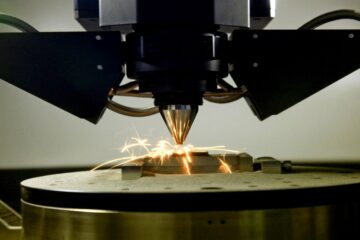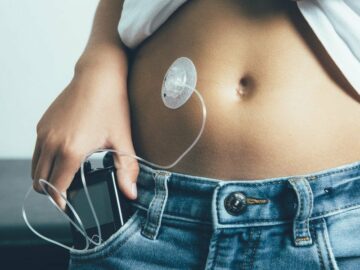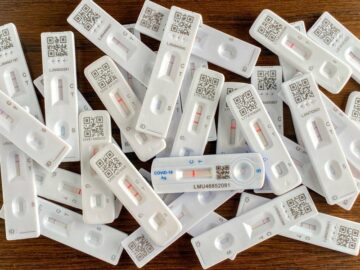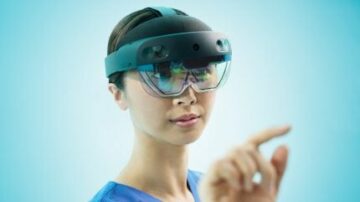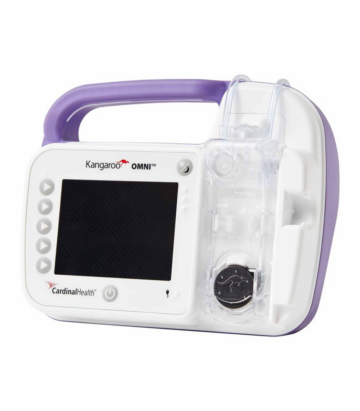<!–
–>
The Medical Devices industry continues to be a hotbed of innovation, with activity driven by increased need for homecare, preventative treatments, early diagnosis, reducing patient recovery times and improving outcomes, as well as a growing importance in technologies such as machine learning, augmented reality, 5G, and digitalization. In the last three years alone, there have been over 450,000 patents filed and granted in the Medical Devices industry. , according to GlobalData’s report on Internet of Things in Medical Devices: Medical Imaging Informatics.
However, not all innovations are equal and nor do they follow a constant upward trend. Instead, their evolution takes the form of an S-shaped curve that reflects their typical lifecycle from early emergence to accelerating adoption, before finally stabilising and reaching maturity.
Identifying where a particular innovation is on this journey, especially those that are in the emerging and accelerating stages, is essential for understanding their current level of adoption and the likely future trajectory and impact they will have.
150+ innovations will shape the Medical Devices industry
According to GlobalData’s Technology Foresights, which plots the S-curve for the Medical Devices industry using innovation intensity models built on over 550,000 patents, there are 150+ innovation areas that will shape the future of the industry.
Within the emerging innovation stage, ingestible sensors, wireless gastric stimulation devices, and remote nerve stimulation devices are disruptive technologies that are in the early stages of application and should be tracked closely. Dosage monitoring inhalators, programmable infusion pumps, and athletic monitoring sensors are some of the accelerating innovation areas, where adoption has been steadily increasing. Among maturing innovation areas are blood glucose sensors and medical emergency response Systems, which are now well established in the industry.
Innovation S-curve for Internet of Things in the Medical Devices industry
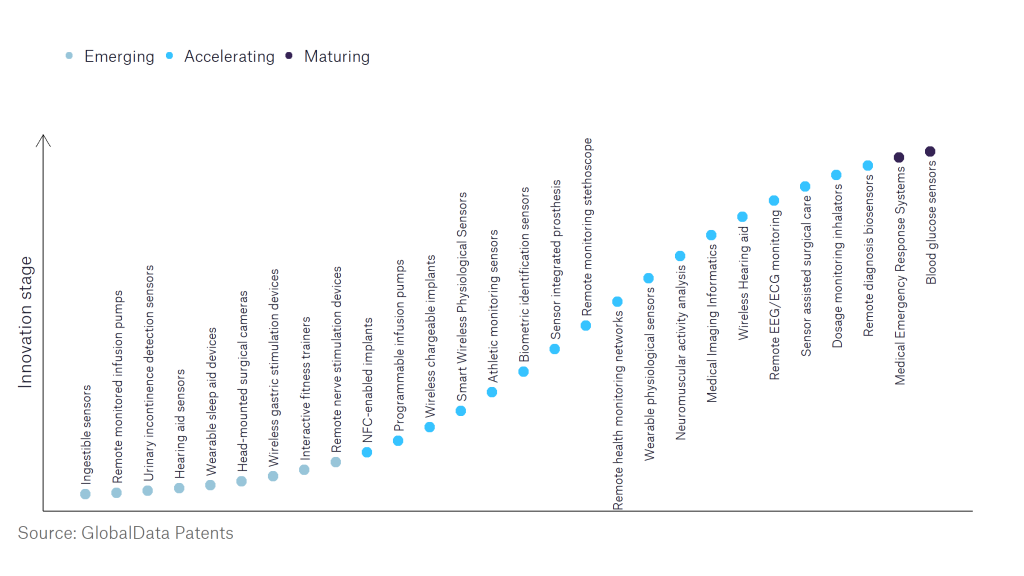
Medical imaging informatics is a key innovation area in Internet of Things
Medical imaging informatics is the process of delivering medical imaging services within a healthcare network with the help of information technology. It replaces the conventional methods of imaging as it is easy to perform, provides faster results, and is affordable.
GlobalData’s analysis also uncovers the companies at the forefront of each innovation area and assesses the potential reach and impact of their patenting activity across different applications and geographies. According to GlobalData, there are 90+ companies, spanning technology vendors, established Medical Devices companies, and up-and-coming start-ups engaged in the development and application of medical imaging informatics.
Key players in medical imaging informatics – a disruptive innovation in the Medical Devices industry
‘Application diversity’ measures the number of different applications identified for each relevant patent and broadly splits companies into either ‘niche’ or ‘diversified’ innovators.
‘Geographic reach’ refers to the number of different countries each relevant patent is registered in and reflects the breadth of geographic application intended, ranging from ‘global’ to ‘local’.
Patent volumes related to medical imaging informatics
Source: GlobalData Patent Analytics
Heartflow is one of the leading patent filers in the field of medical imaging informatics. Some other key patent filers in the field include Siemens and Koninklijke Philips.
In terms of application diversity, Applied Lifesciences & Systems leads the pack, followed by Elekta and LVIS. By means of geographic reach, UCB holds the top position, followed by Applied Lifesciences & Systems and LVIS in the second and third spots, respectively.
Medical imaging informatics has had applications in image-guided therapy, discovering biomarkers for imaging, and diagnostic radiology for the past few decades. New approaches involving AI and machine-learning solutions that help radiologists perform various image analysis tasks, such as image enhancement, segmentation, and detection of abnormalities will be driving factors for this market in the future. This will lead to a more comprehensive and precise diagnosis, prompt prognosis, and efficient treatment planning.
To further understand the key themes and technologies disrupting the Medical Devices industry, access GlobalData’s latest thematic research report on Medical Devices.
- SEO Powered Content & PR Distribution. Get Amplified Today.
- Platoblockchain. Web3 Metaverse Intelligence. Knowledge Amplified. Access Here.
- Source: https://www.medicaldevice-network.com/data-insights/innovators-iot-medical-imaging-informatics-medical-devices/
- 000
- 5G
- 7
- a
- accelerating
- access
- According
- across
- activity
- Adoption
- affordable
- AI
- All
- alone
- among
- analysis
- and
- Application
- applications
- applied
- approaches
- AREA
- areas
- around
- article
- athletic
- augmented
- Augmented Reality
- auto
- before
- blood
- breadth
- broadly
- built
- button
- closely
- Companies
- comprehensive
- constant
- continues
- conventional
- Corp
- countries
- Current
- curve
- data
- decades
- delivered
- delivering
- Detection
- Development
- Devices
- different
- digitalization
- discovering
- disruptive
- Diversity
- dosage
- driven
- driving
- each
- Early
- efficient
- either
- emergence
- emergency
- emerging
- engaged
- especially
- essential
- established
- Ether (ETH)
- evolution
- factors
- faster
- few
- field
- Finally
- follow
- followed
- forefront
- form
- from
- further
- future
- geographic
- geographies
- GlobalData
- granted
- grants
- Group
- Growing
- healthcare
- help
- holds
- HTTPS
- identified
- image
- image analysis
- Imaging
- Impact
- importance
- improving
- in
- include
- increased
- increasing
- industries
- industry
- information
- information technology
- infusion
- Innovation
- innovations
- innovators
- instead
- Intelligence
- Internet
- internet of things
- iot
- IT
- journey
- Key
- largest
- Last
- latest
- lead
- leading
- Leads
- learning
- Level
- likely
- LINK
- machine
- machine learning
- Market
- maturity
- max-width
- means
- measures
- medical
- medical devices
- medical imaging
- methods
- models
- monitoring
- more
- Need
- network
- New
- news
- number
- offices
- official
- ONE
- Other
- Pack
- particular
- past
- patent
- Patents
- patient
- perform
- planning
- plato
- Plato Data Intelligence
- PlatoData
- players
- position
- potential
- primary
- process
- produce
- provided
- provider
- provides
- pumps
- radiology
- ranging
- reach
- reaching
- Reality
- recovery
- reducing
- refers
- reflects
- registered
- related
- relevant
- remote
- report
- research
- response
- Results
- Second
- segmentation
- sensors
- Services
- Shape
- Share
- should
- solid
- Solutions
- some
- specific
- Splits
- Stage
- stages
- start-ups
- such
- SVG
- takes
- tasks
- Technologies
- Technology
- terms
- The
- The Future
- the world
- their
- thematic
- therapy
- things
- Third
- three
- times
- to
- top
- trajectory
- treatment
- Trend
- typical
- underlying
- understand
- understanding
- upward
- various
- vendors
- volumes
- which
- will
- wireless
- within
- world
- world’s
- years
- Your
- zephyrnet

